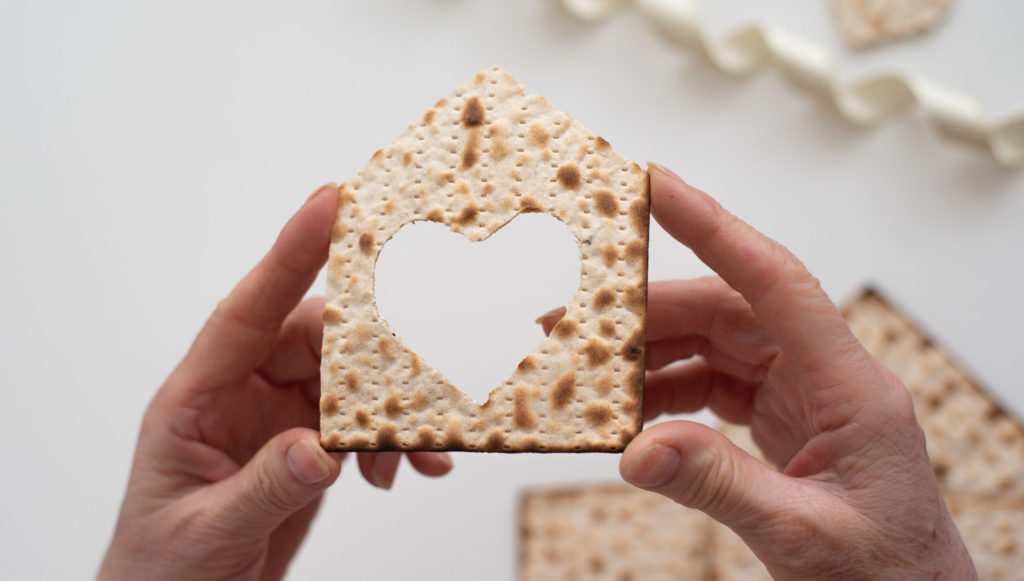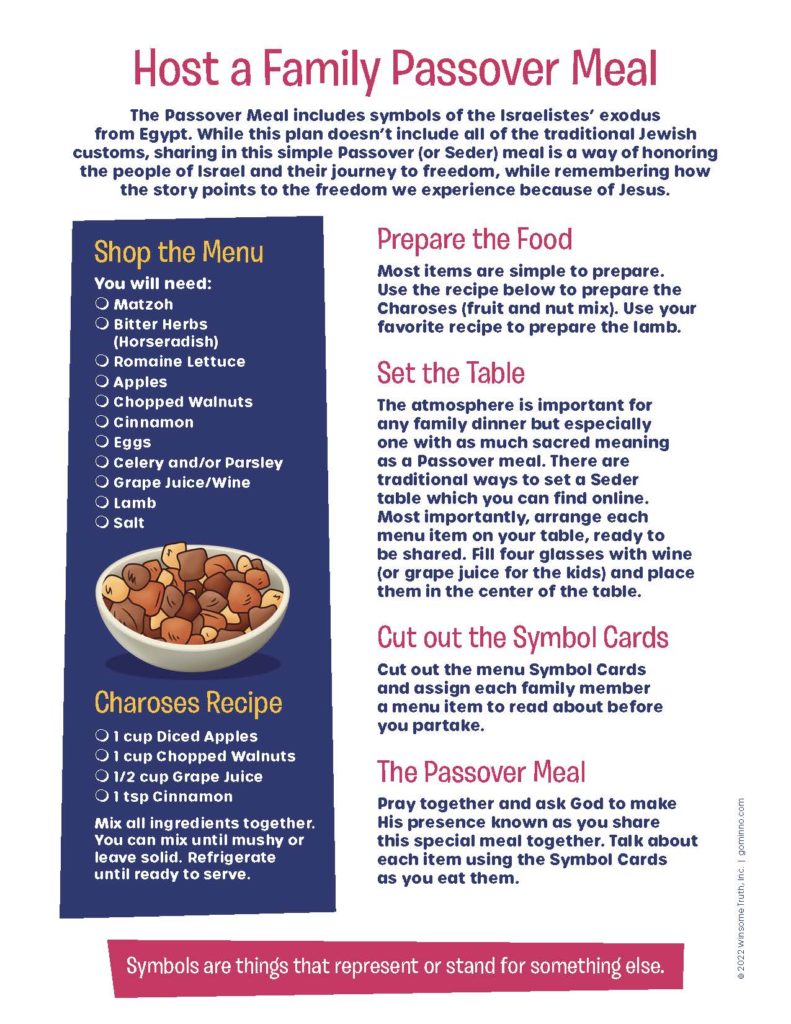
As parents, we have the incredible privilege and opportunity to guide the hearts of our children as they navigate their journey of faith. When we look at our role as such, it allows us to embrace faith-based holidays and liturgy with joy and anticipation. With a little planning and lots of prayer, we can help our children understand the heart and history of their faith.
WHY SHARE A TRADITIONAL PASSOVER MEAL WITH CHILDREN?
I grew up in a Charismatic evangelical church, and we didn’t practice many church traditions. When I was in high school I had a friend who was Episcopalian. He invited me to his home to share a Seder dinner with his family. I was incredibly moved—even at the age of 16—by the history and tradition that was represented in the meal. Since then, my parents have participated in the tradition with their Jewish friends. We never knew the depth of meaning we were missing out on and have thoroughly enjoyed the times we’ve engaged in a Passover meal with friends and loved ones.
You can share the beautiful custom of a Passover or Seder dinner with your kids and family whether you grew up observing the tradition or not. It can be overwhelming to think about sharing foundations of the Christian faith with our children. Ideas such as immaculate conception, Jesus’ death, and resurrection are way beyond our own understanding, let alone that of our kiddos. But the very essence of faith is taking the unseen and unbelievable and believing with hope . . . a hope that transcends human understanding and ultimately transforms our life from a young age.
HOW TO START A FAMILY PASSOVER MEAL TRADITION
First, spend some time reading the exodus story in the Bible. Focus on Exodus 6 (where God promises deliverance) and Exodus 12 (where He instructs Moses and Aaron to observe the Passover and Festival of Unleavened Bread).
In order to help your children understand the significance of the Passover in the midst of the Easter season, you can explain to them that just as God used Moses to help deliver His people from Egypt, He later sent His son, Jesus, to deliver us from sin and from being separated from Him. There is a lot of talk of sacrifice in this story. Whether you decide to go in-depth in that concept or not, explain that Jesus is the ultimate sacrifice, allowing us to be reconnected with God.

Download our Easter Family Guide to get your Family Passover Meal Materials
Below you will find a list of the traditional items used to create the Passover meal in Jewish custom. It is important to remember that the Passover Meal is very meaningful in symbolizing the exodus from Egypt. While you may not share the entire story of the Old Testament with your children at this time since we are focusing on Easter, you can simply share with your children that this meal is a way of honoring the people of Israel, their journey to freedom, and ultimately the freedom we experience because Jesus came to be the ultimate sacrifice. I have taken the liberty to add traditional Christian views into this post that don’t necessarily express the beliefs of Judaism or its customs. But there is beauty in combining tradition and belief from different people of faith with a goal of communicating hope and redemption.
STEP BY STEP FAMILY PASSOVER MEAL PREP
Step 1: Set aside a time during the Passover season. Passover is a moveable feast, which means the dates are not the same each year.
Step 2: Invite family and friends over to share in this special meal. We’ve been doing this every year with our extended family and the cousins love taking turns reading about each symbol aloud.
Step 3: Prepare your Passover meal menu. The great part about this symbolic meal is that the planning has been done for you. Simply familiarize yourself with the items and give yourself time to shop for and prepare the more uncommon foods. We’ve included a shopping list and recipe in our Easter Family Guide.
Step 4: Read through the symbol cards and devotional in our Easter Family Guide. Print and cut the cards so they are ready for family members (especially kids) to participate.
Step 5: Use the devotional script in our guide to walk your family through this sacred meal.
TRADITIONAL PASSOVER MEAL MENU
MATZOH: three unleavened matzohs are placed within the folds of a napkin as a reminder of the haste with which the Israelites fled Egypt, leaving no time for the dough to rise. Two are consumed during the meal, and one is hidden to be found later.
SHARE IT!
When God’s people escaped Egypt, they had to go quickly. Matzoh is called “unleavened” bread because it is made without yeast which helps traditional dough rise over time. Since Matzoh is made quickly, the bread represents the hurry with which the Israelites left Egypt.
MAROR: bitter herbs, usually horseradish or romaine lettuce, used to symbolize the bitterness of slavery.
SHARE IT!
God’s people spent many, many years as slaves in Egypt before being set free. Just like God used Moses to help deliver the Jewish people from slavery, He sent Jesus to die on the cross, to forgive us of our sins, and to be in relationship with us so we can experience true freedom in Christ.
CHAROSES: a mixture of apples, nuts, wine, and cinnamon, as a reminder of the mortar used by the Jews as they worked as slaves to construct buildings.
SHARE IT!
While they were slaves, the Jewish people did a lot of building. This food represents the mortar or paste they used to put bricks together as they worked hard to build in Egypt.
BEITZAH: a roasted egg, as a symbol of life and the perpetuation of existence.
SHARE IT!
The egg represents life and the hope that God’s people would continue to live and thrive after He delivered them out of slavery. Because of what Jesus did for us on the cross, we also share the hope of life today.
KARPAS: a vegetable, preferably parsley or celery, representing hope and redemption; served with a bowl of salted water to represent the tears shed.
SHARE IT!
This vegetable represents hope because vegetables are good for our bodies and offer healing and health. We serve it in saltwater to represent the tears shed by the Israelites along their journey out of slavery.
ZEROAH: traditionally a piece of roasted lamb, symbolizing the paschal sacrificial offering. (You can use any type of meat on a bone for this symbol if needed.)
SHARE IT!
This lamb represents the offering made as a remembrance of Passover. In the Old Testament, God required animal sacrifices as repentance for sins and reminders of important occasions. When He died on the cross, Jesus became the ultimate and last sacrifice! Eating this lamb represents the last offering and reminds us of the sacrifice Jesus made on the cross for us.

